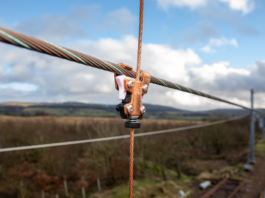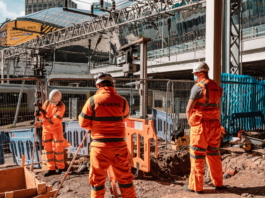Electrification – everyone is talking about it. New 25kV AC overhead line systems are planned, or already going in, on the Great Western main line, in the North West, up the middle of the country and in the South Wales valleys. It is therefore easy to forget that the commuter heartland of the Home Counties is already fully electrified, but using a 750V DC third-rail system. Of course everyone knows it’s there, but it isn’t talked about – it just is.
More power needed
So, to redress the balance, The Rail Engineer decided to look at some major work taking place in Kent. Here, South Eastern Trains is introducing 12-car trains between London (Cannon Street, Charing Cross and London Bridge) and Dartford, Gravesend, Hayes and Sevenoaks. These Class 465 units will replace the current 10-car units giving much-needed extra capacity on the routes.
However, one inescapable fact of life is that 12-car trains use more electrical power than 10-car trains. And as the existing power supply system was already at its limit, improvements were needed.
Network Rail therefore contracted UK Power Networks Services (UKPN Services) to upgrade most of the system before the introduction of the new trains in December 2013 – and then bring the rest of it up to the same standard by the end of 2014 when extra trains will be added to the timetable.
The DC power for the third rail system is provided by a series of substations along the line. Between these are Track Paralleling Huts (TP Huts) which supply the other ends of the two sections, a system known as double-end feeding.
Currently, the system runs at a nominal 660V but the introduction of the new 12-car trains will require this to be uplifted to a nominal 750V. There are naturally losses along the track but it is essential that the supply doesn’t drop below 660-680V around Farringdon, 680V at Southwark and 695V at Cannon Street to prevent trains shutting down.
Enhancement is needed
To bring the power supply up to the new specification involved a lot of work and a tight timescale. Phase 1, to be completed by December 2013, was forecast to be around £30 million and included the renewal of DC switchboards and the upgrade of track equipment at 18 substations, three of which also needed new transformer and rectifiers. In addition, the voltage uplift had to be carried out at more than 20 substations and one completely new TP hut had to be installed along with re-sectioning work. Taking into account the work required at other TP Huts, a total of 48 locations were involved in this Kent Power Supply Enhancement (PSE).
Lee Ramsay, UKPN Services’ section manager, explained that most of the work would be changing out the old DC track breakers in the TP Huts and half a dozen of the substations. Changing the breakers would also require the cables to be changed, particularly due to the higher voltages and currents (now up to 7.5kA). What’s more, those cables would have to be doubled up for 30% of the distance from each end of the section, when the bulk of the load would be met by supply from one end. In the centre of the section (40%), where power would effectively be fed from each end, a single cable would be sufficient.
1000mm2 braided aluminium cable was selected for the positive feed, with 800mm2 being sufficient for the negative return. Cables were sourced from Western Rail Services and Cleveland Cable and the longer stretches were laid down using cable drums on a special lorry fitted with a HIAB. Much of the cable laying has been undertaken by Sonic Rail Services (SRS). Short lengths are being placed by hand and special low-smoke zero-halogen (LSZH) cables will be used through the tunnels at Blackheath, Greenhithe and Elmstead Woods.
While the new cable was being installed, checks were made on the quality of the earthing and any irregularities notified to Network Rail. In many cases, new earth farms were installed – eight earthing pins 2.5 metres apart in a grid connected by braided copper cable.
UKPN Services supplied all of the cable and other fittings. Breakers, transformers and rectifiers were free-issued by Network Rail, with the DC breakers and the permanent DC breaker modules coming from Hawker Siddeley Switchgear.
Restricted access
As much preparatory work was done as possible, as the actual installation of the wiring had to take place in short, 2.5-hour possessions at night (access was normally limited to 01:00 to 04:30). One of the biggest challenges for UKPN Services’ construction manager Jonathan Hedge was arranging access overnight. With the co-operation of Network Rail’s project manager, Mark South, this never became a problem but sometimes the sequence of installations was changed to fall in with planned blockades and possessions.
The new kit was installed in stages during the week and fitted to a temporary TP hut with the new breakers. Then the actual changeover of each section took place on longer, weekend possessions. Following that, the redundant cable and the temporary hut would be removed. There were four such TP Huts available so these were rotated along the route. Scheme managers Mark O’Callaghan and Ed Leonard had the complex job of arranging the schedule and making sure that the free-issue equipment arrived in the right place at the right time.
After all the work is completed, and the old cables and temporary breakers tidied away, the sites will be landscaped. Terram Weedguard geotextile will be overlaid with 150mm of recycled ballast and the fencing will be modified to suit the new installation.
And that’s it – more or less. Some of the substations and TP Huts contained asbestos so that is being dealt with. Phase 1 will be finished by 1 December 2013 ready for the new trains and the new timetable. So if you ride on one of the new 12-car trains in the New Year, between London and Gravesend, just remember where the power comes from.
![P1050229 [online]](http://railengineer.uk/wp-content/uploads/P1050229-online-1024x768.jpg)


